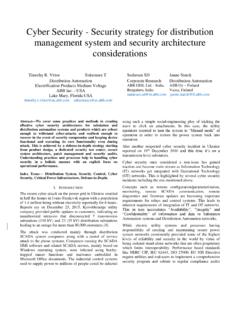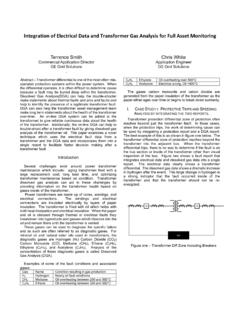Transcription of Circuit Breaker Ratings – A Primer for Protection Engineers
1 Circuit Breaker Ratings A Primer for Protection Engineers Bogdan Kasztenny, Schweitzer Engineering Laboratories, Inc. Joe Rostron, Southern States, LLCA bstract This paper explains the asymmetrical short- Circuit interrupting current rating for high-voltage Circuit breakers. The paper teaches how the decaying dc component in the asymmetrical fault current affects the Breaker , and it explains how the X/R ratio and the relay operating time affect the asymmetrical current Breaker rating. The paper briefly introduces, and illustrates with field cases, several ultra-high-speed Protection principles that can operate in just a few milliseconds. The paper then explains how to derate a Breaker for the relay operating time that is shorter than the standard reference value of cycle. The paper calculates the rating loss due to fast tripping and suggests that applying customary margins when selecting breakers may be sufficient to mitigate the effect of ultra-high-speed relays without the need to replace breakers.
2 I. INTRODUCTION The four major components of any Protection system are instrument transformers, protective relays, Circuit breakers (CBs), and control power circuits. Current and voltage instrument transformers supply input signals to protective relays. Protective relays provide a wide range of Protection functions, including but not limited to short- Circuit Protection . When tripped by protective relays, breakers interrupt the fault current to isolate the affected zone from the rest of the power system. In high-voltage applications, the differential and directional comparison schemes, as well as the underreaching distance and overcurrent elements, provide instantaneous Protection against short circuits. With security as the paramount performance factor, the faster and more dependable the Protection system, the better. With all other factors equal, a faster relay is always preferred over a slower one. Instrument transformers create well-recognized challenges for protective relays.
3 Designed for the fundamental frequency component, instrument transformers may introduce transient errors. Capacitively coupled voltage transformers (CCVTs) generate slowly-decaying components in their output voltages that challenge both speed and security of distance Protection elements, especially in weak systems. Current transformers (CTs) may saturate due to high currents or long-lasting decaying direct current component (dc) offset in the primary current. Protective relay designers and practitioners have a good grasp of these instrument transformer transients, limitations, and failure modes. For example, we know how to derate a CT to account for the actual CT burden, dc offset (X/R ratio), residual flux, or low-frequency operation. In contrast to their focus on instrument transformers, relay practitioners pay less attention to the other component of the Protection system the Circuit Breaker .
4 This paper aims at closing this gap and introducing Protection practitioners to the basics of Breaker rating. Manufacturers specify the fault current interrupting capacity of their breakers for a set of reference conditions including, among other factors, voltage, frequency, decaying dc offset in the fault current, relay operating time, temperature, and altitude. This paper teaches the basics of how breakers are specified and explains rules for derating breakers for operating conditions that differ from the standard reference values. Special attention is given to the decaying dc offset in the short- Circuit current and the relay operating time. As per current standards, the fault current interrupting rating of a Breaker accounts for the asymmetrical fault current interruption; , it accounts for the decaying dc offset in the fault current. The decaying dc component is time varying. It subsides and makes the current interruption an easier task with the passing of time.
5 The key standards for CBs, ANSI/IEEE [1] and the IEC counterpart IEC 62271-100 [2], use the X/R ratio of 17 (60 Hz system) and the relay operating time to establish a reference condition for the decaying dc component. With these assumptions, the standards ask Breaker manufacturers to specify the nameplate interrupting rating for an asymmetrical current. As a result, Breaker applications are simplified because the users can directly apply the nameplate rating without extra calculations if their relays are not faster than cycle and their system X/R ratio is at or below 17. How does one derate a Breaker for relay operating times that are faster than cycle or a system X/R ratio higher than 17? Breaker practitioners routinely derate breakers for systems with higher X/R ratios. Historically, however, the relay operating time was rarely questioned, and today, users normally do not derate breakers to account for specific relay operating times.
6 Today, new types of relays have emerged that operate faster than cycle [3]. Application of these relays calls for evaluating Breaker Ratings . This paper is a Primer for Protection Engineers , and it teaches how the Breaker rating depends on the X/R ratio and the relay operating time (Sections II and III). It briefly discusses relay operating times and the new principles that allow reducing operating times to just a few milliseconds (Section IV). The paper then introduces, explains, and illustrates the Breaker derating formula for ultra-fast tripping times (Section V). The paper analyzes the impact of the relay operating time (faster and slower than the reference value of cycle) for a few Breaker interrupting times. The paper shows that the changes in the Breaker Ratings due to ultra-fast relay operation are within typical margins applied by Breaker practitioners. II. Circuit Breaker SPECIFICATION CONVENTION Requirements and specifications for power Circuit breakers and Circuit switchers have been established in various standards over the years.
7 These standards are principally the ANSI/IEEE standards, , , and , and the IEC counterpart, IEC 62271-100. The standard for Circuit switchers is ANSI/IEEE We briefly summarize several key specifications and explain their purpose and application [1] [2] [4]. 1) Normal Operating Conditions These specifications refer to environmental conditions, primarily the ambient temperature and the altitude. The ANSI standards specify a temperature range between 30 C ( 22 F) and +40 C (104 F) and an altitude below 1,000 m (3,300 ft). 2) Rated Power Frequency System frequency has a significant impact on the interrupting capability of a Breaker because it dictates the rate of change of the current near the current zero crossing. The breakers are specified at either 60 Hz or 50 Hz, and they need to be derated for operation at different frequencies. 3) Maximum Operating Voltage This rating specifies the maximum line-to-line rms voltage for a Breaker .
8 The ANSI and IEC standards differ slightly on the nominal values they recommend. For example, the IEC may list 525 kV while ANSI may list 550 kV. These differences result from the rated network voltage practices in various parts of the world. 4) Rated Voltage Range K-Factor This rating originated with older Breaker technologies (such as oil and air magnetic breakers) in which the interrupting capability is inversely proportional to the operating voltage. The K-factor is the ratio of the rated maximum voltage to the lowest operating voltage for which the inverse relationship between the operating voltage and the interrupting current holds true. The K-factor is a limit for derating the interrupting current for a varying operating voltage. Older Breaker technologies had significantly higher current interrupting capability at lower voltage; hence, breakers were essentially constant MVA-rated fault clearing devices. At the time they were most common, the standards used the concept of the rated (symmetrical) short- Circuit current and allowed derating based on the operating voltage.
9 Today s Breaker technology (SF6) does not have this same characteristic: the increase in the current interruption capability at lower operating voltages is usually rather small and as such is frequently ignored. The K-factor, therefore, does not apply to modern breakers. 5) Rated Dielectric Strength This group of Ratings is specified by a series of tests, each relating to typical power system overvoltage transients, that a Breaker needs to pass. These tests include conditions such as low-frequency overvoltage (nominal frequency, wet and dry conditions), lightning impulse (basic impulse level), chopped wave, bias test, and switching impulse. 6) Rated Transient Recovery Voltage Transient Recovery Voltage (TRV) relates to the ability of the Breaker insulating medium to recover its insulating properties after current interruption. A Breaker needs to recover its insulation for the specified TRV waveform across its terminals.
10 The standards consider this waveform a function of the system alone and neglect any interaction between the system and the Breaker . TRV is a complex requirement that depends on the system conditions such as fault type. The standards specify several TRV waveforms (conditions) assuming different fault and system scenarios such as terminal faults or short line faults. 7) Rated Continuous Current This value relates to the Breaker s thermal design and the allowable temperature rise from the losses dissipated across the primary contact and connection resistances. This rating needs to be considered in relation to the ambient temperature. 8) Rated Short- Circuit Current This value refers to the maximum rms symmetrical short- Circuit current (the current without any decaying dc component) that can be safely interrupted by the Breaker . Historically, this specification was used to convey the Breaker s total interrupting capacity, neglecting the impact of the decaying dc component and leaving to the user the derating for asymmetrical short- Circuit current.



